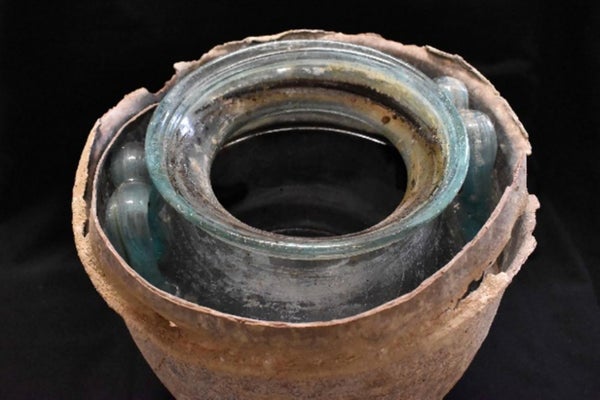The Oldest-Wine-in-the-World Title Goes to a 2,000-Year-Old White Found in Southwestern Spain
The Oldest-Wine-in-the-World Title Goes to a 2,000-Year-Old White Found in Southwestern Spain
A wine still liquid after two millennia turned up at a construction site near Seville, Spain

The liquid found in this urn in a burial chamber in Carmona, Spain is the oldest wine in the world.
Juan Manuel Román/”New archaeochemical insights into Roman wine from Baetica,” by Daniel Cosano, et al., Journal of Archaeological Science: Reports, Vol No. 57, 2024, Article No. 104636; June 16, 2024 (CC BY 4.0)
In 2019 an excavation team made an extraordinary discovery in the town of Carmona in southwestern Spain. At the bottom of a shaft found during construction work, the team uncovered a sealed burial chamber from the early first century C.E.—untouched for 2,000 years.
Six of the eight wall niches in the underground vault contained urns and grave goods, including a bottle that still contained perfume residue. One of the niches, labeled L-8 and located to the right of the entrance, gave archeologists a surprise. A glass urn placed in a lead case was filled to the brim with a reddish liquid. According to a new study in the Journal of Archeological Science: Reports, a team led by chemist José Rafael Ruiz Arrebola has now found that it is 2,000-year-old wine—more specifically, white wine. This makes the find the world’s oldest wine still in liquid form. It is around 300 years older than the previous record holder, a Roman wine found in Speyer, Germany, in 1867.
The wine from the Carmona site was no longer suitable for drinking, and it had never been intended for that purpose; the experts found bone remains and a gold ring at the bottom of the glass vessel. The burial chamber was the final resting place for the remains of the deceased, who were cremated according to Roman custom.
On supporting science journalism
If you’re enjoying this article, consider supporting our award-winning journalism by subscribing. By purchasing a subscription you are helping to ensure the future of impactful stories about the discoveries and ideas shaping our world today.
The experts concluded from the condition of the burial chamber, which also contained partially preserved textiles and dry urns, that the liquid from L-8 was part of the original contents of the vessel and not groundwater or condensation water that subsequently seeped in. Apparently the lid of the glass urn and the surrounding lead case prevented the liquid from evaporating over time.
To find out what kind of liquid accompanied the deceased during the last 2,000 years, the experts resorted to chemical analysis. Ruiz Arrebola’s team suspected from the outset that it might have been wine—the drink had great spiritual significance in the ancient world and was closely linked to religious rites and burials. It was clear from the start, however, that after 2,000 years, the liquid would have little in common with the original wine. The research group therefore analyzed chemical traces—the salts and trace elements contained in the grapes and possible traces of alcohol. Finally, Ruiz Arrebola and his colleagues looked for a class of substances that is typical of wine: polyphenols.
The researchers found multiple types of polyphenols in the liquid. This discovery, along with the cultural context of the site, makes it very likely that the liquid was wine. One polyphenol that the team did not find, however, was syringic acid, a breakdown product of the main pigment that gives red wines their typical color. This compound can be used to determine the color of a wine from an archaeological find even if it is in the form of a dried residue.
Ruiz Arrebola’s team concluded, therefore, that the liquid that had reddened over the centuries was white wine. In the paper, the researchers cite first-century Roman author Lucius Iunius Moderatus Columella, who specifically mentioned the production of white wine in what was then the province of Baetica, which includes modern-day Carmona. The mineral profile of the urn’s contents is also similar to modern sherry and fino wines produced in regions near the site.
This article originally appeared in Spektrum der Wissenschaft and was reproduced with permission.


